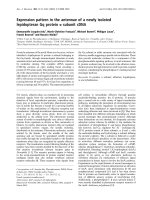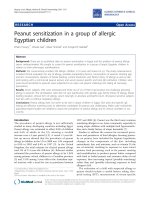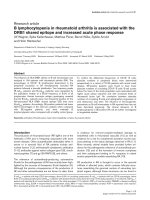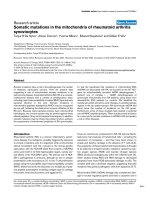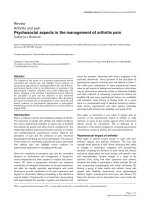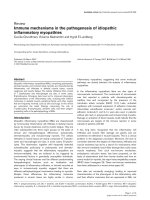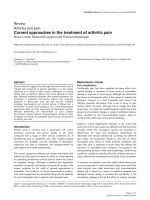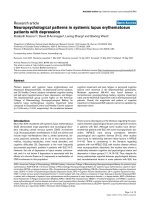Báo cáo y học: "Gender difference in QTc prolongation of people with mental disorders" docx
Bạn đang xem bản rút gọn của tài liệu. Xem và tải ngay bản đầy đủ của tài liệu tại đây (231.83 KB, 6 trang )
BioMed Central
Page 1 of 6
(page number not for citation purposes)
Annals of General Hospital
Psychiatry
Open Access
Primary research
Gender difference in QTc prolongation of people with mental
disorders
Hiroto Ito*
1
, Toshiaki Kono
2
, Shigenobu Ishida
3
and Hisao Maeda
3
Address:
1
National Institute of Public Health, 2-3-6 Minami, Wako, Saitama 351-0197, Japan,
2
Department of Psychiatry, Division of
Neuroscience, Graduate School of Medicine, The University of Tokyo, Japan and
3
Department of Neuropsychiatry, Kurume University School of
Medicine, Japan
Email: Hiroto Ito* - ; Toshiaki Kono - ; Shigenobu Ishida - ;
Hisao Maeda -
* Corresponding author
Abstract
Background: We examined gender difference in QTc interval distribution and its related factors
in people with mental disorders.
Methods: We retrospectively reviewed medical charts of patients discharged from a university
psychiatric unit between November 1997 and December 2000. Subjects were 328 patients (145
males and 183 females) taking psychotropics at their admission. We examined patient
characteristics, medical history, diagnosis, and medication before admission.
Results: Mean QTc interval was 0.408 (SD = 0.036). QTc intervals in females were significantly
longer than those in males. QTc of females without comorbidity was significantly longer than that
of males.
Conclusion: The influence of gender difference on QTc prolongation in people with mental
disorders merits further research.
Background
QT interval prolongation is regarded as an indicator of
potential for malignant ventricular arrhythmia [1]. Many
antiarryhythmic drugs are known to prolong ventricular
repolarisation, and result in the QT interval prolongation.
Since prolonged ventricular repolarisation may provoke
torsades de pointes and sudden death, measurement of
QT interval prolongation is important to identify the
high-risk patients and prevent avoidable negative
outcomes.
Female gender is regarded as a high-risk group of QTc
interval prolongation. QTc interval has been reported to
be longer in females than in males [2]. A meta-analysis of
332 published cases of torsades de pointes associated with
cardiovascular drugs [3] suggested that female were more
prone than male to prolong cardiac repolarization.
Although females appear to be more protected from coro-
nary heart diseases than males in general population [4],
gender differences in QTc interval prolongation and cardi-
ovascular diseases for people with mental disorders are
still unknown.
In addition to cardiac drugs, there are recently many
reports on non-cardiac drugs' effects on QT interval pro-
longation [5-10]. Such drugs include some antihista-
mines, antibiotics, antimalarials, antifungal agents, and
psychotropic drugs [4]. As to psychotropic drugs for peo-
ple with mental disorders, some tricyclic antidepressants
and antipsychotics including thioridazine are reported to
Published: 13 February 2004
Annals of General Hospital Psychiatry 2004, 3:3
Received: 20 June 2003
Accepted: 13 February 2004
This article is available from: />© 2004 Ito et al; licensee BioMed Central Ltd. This is an Open Access article: verbatim copying and redistribution of this article are permitted in all media
for any purpose, provided this notice is preserved along with the article's original URL.
Annals of General Hospital Psychiatry 2004, 3 />Page 2 of 6
(page number not for citation purposes)
be associated with QT interval prolongation [5-7]. A sur-
vey of medico-legal autopsies performed revealed that
phenothiazine derivative was present in 46 of all 49 sud-
den unexpected deaths associated with the use of antipsy-
chotic or antidepressant drugs during the study period in
Finland [8]. Moderate-dose antipsychotic users (>100 mg
in thioridazine equivlalents) was reported to be in a 2.39
times greater risk of sudden cardiac death than non-users
[9]. Reilly et al. [10] estimated the point prevalence of QTc
prolongation in psychiatric patients in various inpatient
and community settings and found that age over 65 years,
use of tricyclic antidepressants, thioridazine, and droperi-
dol were predictors of QTc prolongation.
Although Reilly et al. [10] examined the effect of gender
differences, it was not strongly related to QTc prolonga-
tion as age and psychotropic drugs. To our knowledge,
there were no specific studies on related factors to QTc
prolongation by gender. We hypothesized that female
gender in people with mental disorders could be a risk fac-
tor of QTc prolongation. In this research, we focused on
gender difference in QTc interval distribution and exam-
ined related factors of the QTc prolongation of people
with mental disorders.
Methods
Subjects
We retrospectively reviewed the medical charts of patients
with history of previous psychiatric treatment, discharged
from a psychiatric unit of a university hospital between
November 1997 and December 2000. In this unit, electro-
cardiograms (ECGs) of all admitted patients were exam-
ined within several days from the admission as one of
physical checks to consult other professionals such as car-
diologists if necessary. Since 4 patients were excluded for
missing values, we analyzed 328 patients (145 males and
183 females).
The mean age (SD) of the subjects was 41.1 (17.4) years
old. As to psychiatric diagnosis using Diagnostic Statistical
Manual, 4th edition (DSM-IV), 94 (28.7%) patients were
diagnosed as suffering from schizophrenia, 95 (29.0%)
from mood disorders, and 139 (42.4%) from other.
The mean duration (SD) of taking psychotropic drugs in
years was 7.90 (9.38). Of the subjects, 232 (70.7%) and
90 (27.4%) were taking antipsychotics and antidepres-
sants, respectively. The mean doses (SDs) of antipsychot-
ics (chlorpromazine equivalent / day) and
antidepressants (maprotiline equivalent / day) among
patients taking each cluster of psychotropics were 435
(545) mg and 73.9 (75.1) mg, respectively. Since atypical
antipsychotics (AAPs) were approved in 1996 by the Min-
istry of Health, Labour and Welfare, Japan, only 36
patients received AAPs in the study period. Regarding anti-
depressants, 25 patients were taking selective serotonin
reuptake inhibitors (SSRIs) while 45 patients were taking
tricyclic antidepressants (TCAs).
There were 204 (62.2%) patients with some physical
comorbidities. These included 70 (21.3%) hepatic fail-
ures, 51 (15.5%) cardiovascular diseases, 25 (7.6%) dia-
betes, and 10 (3.0%) cerebrovascular diseases.
Variables
Variables included into the analyses were gender, age at
admission, diagnosis, daily doses of psychotropic drugs,
comorbidities, and QTc interval.
Diagnosis was categorized into schizophrenia, mood dis-
orders, and others according to DSM-IV. Daily doses of
psychotropics were calculated as to antipsychotics (in
chlorpromazine equivalents) and antidepressants (in
maprotiline equivalents) prescribed as regular medication
at the point of ECGs. As distributions of doses of antipsy-
chotics and antidepressants did not follow the normal dis-
tribution, they were categorized into four levels. Dose of
antipsychotics in mg (AP) was divided as following; AP =
0, 0 < AP < 100, 100 ≤ AP < 500, and 500 ≤ AP. Dose of
antidepressants in mg (AD) was divided as following; AD
= 0, 0 < AD < 50, 50 ≤ AD < 100, and 100 ≤ AD. As to
comorbidities, we examined whether patients had cardio-
vascular disease, cerebrovascular disease, hepatic failure
and diabetes at admission or not.
QTc interval measurements were calculated automatically
by a computer algorithm using Bazett's formula (QTc =
QT / square root of RR).
All variables used are provided in Table 1, with values and
their coding for qualitative variables, as well as analysis
which each variable was used by.
Analyses
First, we calculated a mean QTc interval for all subjects,
and compared QTc intervals between males and females
with t-test. We also made a histogram of QTc interval with
a class interval of 0.02 second in each gender.
Second, we carried out two-way analyses of covariance
(ANCOVAs) to examine considerably related factors with
QTc prolongation. We used QTc interval as a dependent
variable, and age at admission as a covariate. As to the two
factors, gender was included as one of them, and each of
seven variables (diagnosis, daily doses of antidepressants
and antipsychotics, and existences of cardiovascular dis-
ease, cerebrovascular disease, hepatic failure, and diabe-
tes) as the other. We also calculated means (SDs) of QTc
interval in each category of each factor other than gender.
If the factor other than gender was significant, we
Annals of General Hospital Psychiatry 2004, 3 />Page 3 of 6
(page number not for citation purposes)
compared QTc intervals between the categories of the fac-
tor. We used Bonferroni correction for multiple
comparisons.
Finally, we carried out one-way ANCOVAs in cases that
the factor other than gender was significant in a two-way
ANCOVA. To exclude the effect of the factor, we applied
one-way ANCOVAs to every subgroup in which the factor
belongs to the same category, using QTc interval as a
dependent variable, gender as a factor, and age at admis-
sion as a covariate. We also calculated means (SDs) of QTc
interval in each gender in every subgroup.
All statistical analyses were performed with the SPSS 11.0
J for Windows. All tests were two-tailed.
Results
The QTc interval was 0.408 ± 0.036 seconds. The QTc
interval in females (0.413 ± 0.036) was significantly
longer than that in males (0.401 ± 0.035; t(326) = 2.861,
p < 0.01). Figure 1 shows the histogram of QTc intervals
in each gender. There were three males and one female
whose QTc intervals were longer than 0.5 seconds.
The results of 7 two-way ANCOVAs are shown in Table 2.
There were no significant interaction effects in any test.
Gender was a singnificant factor in three tests (when diag-
nosis, antipsychotics, and hepatic failure were included as
the other factor). Cardiovascular disease was the only fac-
tor other than gender that was significant. The mean QTc
interval in those with cardiovascular disease was signifi-
cantly longer than that in those without it.
Table 1: Variables used in the study and their locations in the statistical model of each analysis.
Variable (with values and their codes for qualitative variables) t-test two-way ANCOVAs
1)
one-way ANCOVAs
gender indep.var. factor
a)
factor
0male
1female
age at admission covariate covariate
diagnosis factor
b)
0others
1 schizoperenia
2 mood disorders
antipsychotics
2)
factor
b)
00 mg
1 0–100 mg
2 100–500 mg
3500 mg +
antidepressants
3)
factor
b)
00 mg
1 0–50 mg
2 50–100 mg
3100 mg +
cardiovascular disease factor
b)
0absent
1present
cardiovascular disease factor
b)
0absent
1present
hepatic failure factor
b)
0absent
1present
diabetes factor
b)
0absent
1present
QTc interval dep.var. dep.var. dep.var.
indep.var. = independent variable dep.var. = dependent variable 1) We included gender (marked with 'a') as one factor, and one of the other
qualitative variables (marked with 'b') as the other, therefore we carried out 7 two-way ANCOVAs in total. 2) Dose of antipsychotics was
estimated in chlorpromazine equivalents. 3) Dose of antidepressants was estimated in maprotiline equivalents.
Annals of General Hospital Psychiatry 2004, 3 />Page 4 of 6
(page number not for citation purposes)
Table 3 shows the results of one-way ANCOVAs. As cardi-
ovascular disease was a significant factor in a two-way
ANCOVA, we carried out one-way ANCOVAs individually
in those with and without cardiovascular disease. The
mean QTc interval was significantly different by gender
when cardiovascular disease was absent (male < female),
while it was not when present.
Discussion
According to the results of the current study, female gen-
der is a contributing factor in QTc lengthening. Although
the relationship between QTc prolongation and gender
has been discussed in recent cardiovascular researches in
general [4], it has not been well examined in people with
mental disorders.
QTc intervals in females were significantly higher than in
males among the mentally ill "without" cardiovascular
comorbidity. This suggests that a gender difference still
exists in QTc lengthening in persons with mental disor-
ders after excluding effects of cardiovascular comorbidity.
No other factors were related to QTc lengthening in this
study, though some other studies pointed out the influ-
ence of psychotropic drugs to QTc lengthening [2,5-10].
The possible reasons are that the institution in this study
is a university hospital where psychiatrists try to avoid tri-
cyclic antidepressants which reportedly put the patient at
risk for QTc lengthening, and can easily consult with car-
diologists if necessary. But the sample is small, and we
need to study the psychotropic effects on QTc lengthening
in a larger sample.
Histogram of QTc interval in each gender.Figure 1
Histogram of QTc interval in each gender. The lower limit of each range is included in the range, while the upper limit is
not.
< .34 .34 359 .36 379 .38 399 .40 419 .42 439 .44 459 .46 479 .48 499 >= .5
QTc intervals (sec)
Gender (%)
/ CNG
(GO CNG
Annals of General Hospital Psychiatry 2004, 3 />Page 5 of 6
(page number not for citation purposes)
The results of this study cannot lead directly to the conclu-
sion that females without comorbidity having QTc length-
ening are at high risk for cardiovascular diseases. This is
partly because factors related to female gender such as
steroid hormone receptors and ion channels may possess
cardioprotective properties [4]. In fact, there was only one
female with QTc interval of more than 0.5 second, a
threshold of higher occurrence of torsades de pointes,
while there were 3 males [10]. Different life styles by gen-
der such as smoking [11] may also decrease the risks for
cardiovascular diseases in females.
The current study has several limitations. Since we did not
examine the QTc effects on cardiovascular diseases in this
retrospective study, we could not clarify the relationship
between cardiovascular diseases and gender. Potential
influential factors on QTc interval such as body weight
and history of smoking [6] were not included in this ret-
rospective study design. Since persons with mental disor-
Table 2: The effects of gender and other related factors on QTc interval.
Factor other than gender Term in the statistical model Mean (SD) of QTc interval F-value
diagnosis gender 8.559**
diagnosis 1.870
others (n = 139) 0.402 (0.040)
schizophrenia (n = 94) 0.407 (0.033)
mood disorders (n = 95) 0.415 (0.032)
gender • diagnosis 0.253
antipsychotics gender 7.952**
antipsychotics 1.035
0 mg (n = 96) 0.406 (0.036)
0–100 mg (n = 66) 0.405 (0.031)
100–500 mg (n = 103) 0.410 (0.039)
500 mg + (n = 63) 0.409 (0.035)
gender • antipsychotics 1.526
antidepressants gender 1.359
antidepressants 1.036
0 mg (n = 238) 0.405 (0.038)
0–50 mg (n = 26) 0.416 (0.030)
50–100 mg (n = 39) 0.413 (0.031)
100 mg + (n = 25) 0.417 (0.026)
gender • antidepressants 1.752
cardiovascular disease gender 1.114
cardiovascular disease 5.483*
absent (n = 277) 0.405 (0.036)
1)
present (n = 51) 0.420 (0.035)
1)
gender • cardiovascular disease 2.180
cerebrovascular disease gender 2.048
cerebrovascular disease 0.014
absent (n = 318) 0.407 (0.036)
present (n = 10) 0.414 (0.029)
gender • cerebrovascular disease 0.267
hepatic failure gender 4.694*
hepatic failure 0.024
absent (n = 258) 0.408 (0.037)
present (n = 70) 0.407 (0.034)
gender • hepatic failure 0.062
diabetes gender 0.065
diabetes 0.103
absent (n = 303) 0.408 (0.033)
present (n = 25) 0.408 (0.063)
gender • diabetes 2.125
Two-way ANCOVA (analysis of covariance): Gender and each of the 7 variables in the most left column were included as two factors, QTc interval
as a dependent variable, and age at admission as a covariate. 7 tests were performed in total. *p < 0.05, **p < 0.01. 1) As this variable has only two
categories, it is manifest without post-hoc analysis that there is a significant difference between these values.
Publish with BioMed Central and every
scientist can read your work free of charge
"BioMed Central will be the most significant development for
disseminating the results of biomedical research in our lifetime."
Sir Paul Nurse, Cancer Research UK
Your research papers will be:
available free of charge to the entire biomedical community
peer reviewed and published immediately upon acceptance
cited in PubMed and archived on PubMed Central
yours — you keep the copyright
Submit your manuscript here:
/>BioMedcentral
Annals of General Hospital Psychiatry 2004, 3 />Page 6 of 6
(page number not for citation purposes)
ders are about twice as likely to smoke as other people
[11] and men smoke more frequently than females in
Japan [12], a further prospective study is needed.
Conclusions
Our results suggest the presence of QTc prolongation in
female patients with mental disorders and this group
could be at high risk of cardiovascular diseases. Gender
difference should be considered in combination with the
effect of psychotropic drugs on cardiovascular system.
Competing interests
None declared.
Authors' contributions
HI conceived and designed the study and drafted the man-
uscript. TK participated in the design of and carried out
the study, and performed the statistical analysis. SI partic-
ipated in the design of, carried out, and coordinated the
study. HM participated in its design and coordination. All
authors read and approved the final manuscript.
References
1. Akhtar M: Clinical spectrum of ventricular tachycardia. Circula-
tion 1990, 82:1561-1573.
2. Moss AJ: Measurement of the QT interval and the risk associ-
ated with QTc interval prolongation: a review. Am J Cardiol
1993, 72:23B-25B.
3. Makkar RR, Fromm BS, Steinman RT, Meissner MD, Lehmann MH:
Female gender as a risk factor for torsade de pointes associ-
ated with cardiovascular drugs. JAMA 1993, 270:2590-2597.
4. Collins P, Stevenson JC, Mosca L: Spotlight on gender. Cardiovasc
Res 2002, 53:535-537.
5. Yap YG: Risk of torsades de pointes with non-cardiac drugs:
doctors need to be aware that many drugs can cause QT
prolongation. BMJ 2000, 430:1158-1159.
6. Glassman AH, Bigger JT: Antipsychotic drugs: prolonged QTc
interval, torsade de pointes, and sudden death. Am J Psychiatry
2001, 158:1774-1782.
7. Hennessy S, Bilker WB, Knauss JS, Margolis DJ, Kimmel SE, Reynolds
RF, Glasser DB, Morrison MF, Strom BL: Cardiac arrest and ven-
tricular arrhythmia in patients taking antipsychotic drugs:
cohort study using administrative data. BMJ 2002,
325:1070-1072.
8. Mehtonen OP, Aranko K, Malkonen L, Vapaatalo H: A study of sud-
den death associated with the use of antipsychotic or antide-
pressant drugs: 49 cases in Finland. Acta Psychiatr Scand 1991,
84:58-64.
9. Ray WA, Meredith S, Thapa PB, Meador KG, Hall K, Murray KT:
Antipsychotics and the risk of sudden cardiac death. Arch Gen
Psychiatry 2001, 58:1161-1167.
10. Reilly JG, Ayis SA, Ferrier IN, Jones SJ, Thomas SHI: QTc-interval
abnormalities and psychotropic drug therapy in psychiatric
patients. Lancet 2000, 355:1048-1052.
11. Lasser K, Boyd J, Woolhandler S, Himmelstein DU, McCormick D,
Bor DH: Smoking and mental illness: a population-based
prevalence study. JAMA 2000, 284:2606-2610.
12. Japan Ministry of Health, Labour and Welfare: The national nutrition sur-
vey in Japan 2001 Tokyo 2003.
Table 3: Gender difference in QTc interval when the factor significant in two-way ANCOVA is fixed.
Factor significant in two-way ANCOVA Mean (SD) of QTc interval F-value
cardiovascular disease
absent (n = 277) 10.251**
Male (n = 122) 0.398 (0.035)
Female (n = 155) 0.411 (0.036)
present (n = 51) 0.353
Male (n = 23) 0.421 (0.034)
Female (n = 28) 0.420 (0.037)
One-way ANCOVA (analysis of covariance): Gender was included as a factor, QTc interval as a dependent variable, and age at admission as a
covariate. There was only one factor significant in two-way ANCOVAs (cardiovascular disease), and it has two categories (absent, and present),
therefore 2 tests were performed in total. **p < 0.01.
